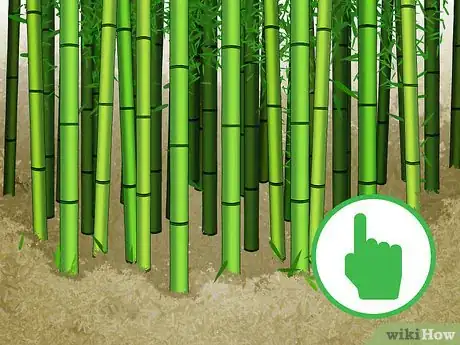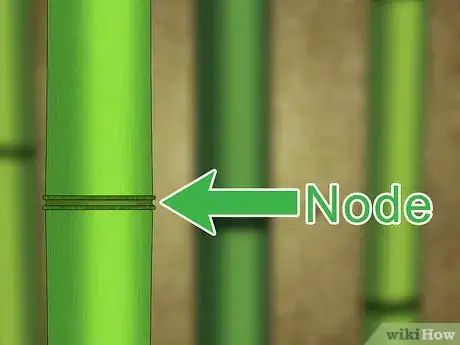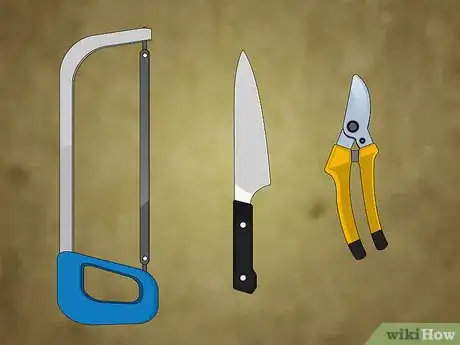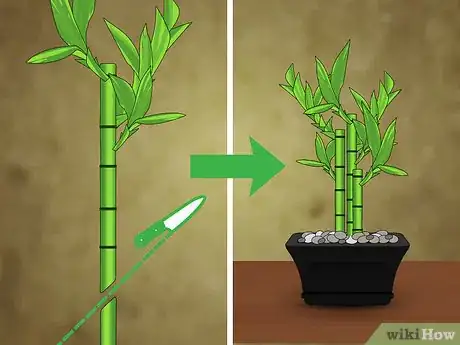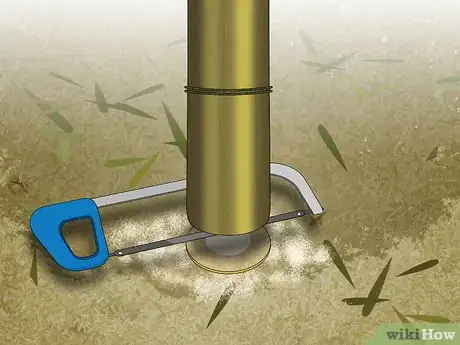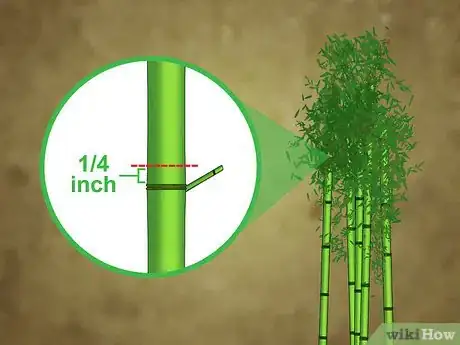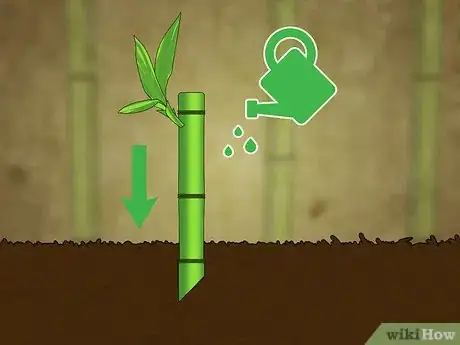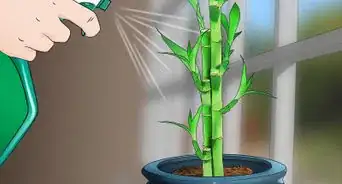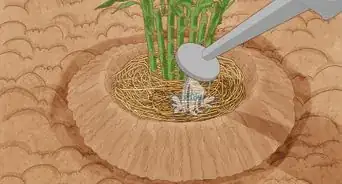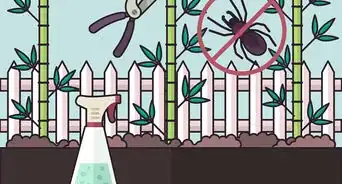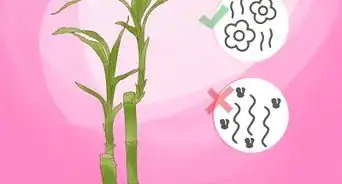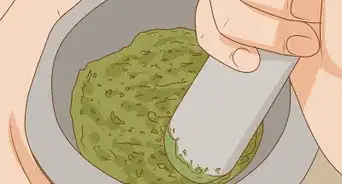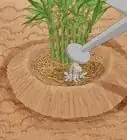This article was co-authored by Ryan Glynn, CPA. Ryan Glynn is a Plant Specialist, Interiorscaper, and the Founder of Chicago Plants, LLC. He specializes in houseplant care, interior plant-scaping, and gardening. Ryan and Chicago Plants have been featured in several media outlets such as TimeOut Magazine and the Chicago Tribune. Ryan holds a BBA and Master’s degree in Accounting from The University of Wisconsin-Madison.
There are 9 references cited in this article, which can be found at the bottom of the page.
This article has been viewed 224,595 times.
Bamboo has many advantages over several other kinds of wood. It grows phenomenally quickly, making it less expensive than many other varieties. The grain is attractive, and it's set in such a way as to make the wood highly versatile. The qualities that make bamboo so great for so many projects do have a disadvantage: they make the wood more difficult to cut than other types. It's possible to cut bamboo, though, with a sharp instrument.
Steps
Preparing the Bamboo for Cutting
-
1Choose your stalks. If you are using bamboo for a project, you should generally choose green wood because it’s easier to use. If it’s cold outside, you will want to heat the bamboo stalks so they won’t split.
- Put masking tape where you are going to cut. It can stop the wood from splintering. Use a sharp pruner to cut bamboo that is less than 1-inch in diameter. If it’s more than that, you should use a sharp handsaw. Pick one with straight teeth or it will tear the plant’s fibers.
- Use your measuring tape, or formal project plans, to determine how wide a piece of bamboo you need. Find bamboo of approximately that thickness, understanding that bamboo does not come in uniform diameters.[1]
-
2Find the nodes. Most people use or cut the stem of the bamboo plant because this is the part that grows above ground. It usually grows straight.[2]
- The stems contain nodes that strengthen it. That’s the purpose they serve to the plant. The number of nodes may differ, depending on the type of bamboo. You can find nodes by looking for areas that have two rings positioned closely together. The lower ring of the node is called the sheath ring, and the upper one is called the stem ring.
- Most bamboo is hollow inside. The thickness of the wall differs depending on the species of bamboo. One bamboo species is almost solid.[3]
Advertisement -
3Lubricate the bamboo before cutting it, this will make it easier to cut through. It must be cut at an angle of 45 degrees between the nodes.
- Make sure to work in a room temperature environment with room temperature tools to again prevent splitting.
- Mineral oil is often used to lubricate bamboo.
Cutting the Bamboo
-
1Pick the right cutting instrument. If you’re using small amounts of bamboo for something like a small home decorative project, simply roll a sharp knife through the bamboo stalk.[4]
- Bamboo can be cut precisely using a fine wood saw or a metal saw. As it is a fibrous material, you should be careful at the end of the cut to avoid splits. Go slow at the end. Take out a relatively sharp knife. Always chop the bamboo diagonally. You can make your cut with shears for bamboo stalks 1 inch (2.54 cm) or less in diameter. For thicker pieces, use a saw.
- If the project is larger, you’ll need a table and a very sharp handsaw. Position the part you want to cut over the edge and grasp the stalk on the table. Now, simply saw the end of the bamboo off. It’s also possible to drill through bamboo.
- For pieces thicker than one inch, use a fine toothed saw and a stable work area as well as a way to secure both ends of the bamboo (masking tape works great). Then you secure the two ends to the work space and mark where you want to cut and then... cut it. Consider using a clamp on the workbench to hold the stalk. If you wrap the section of bamboo that goes in the clamp with a towel, this will prevent the clamp from marring the surface of your wood.
-
2Cut the bamboo stalks. Perhaps you want to cut bamboo stalks to put in a decorative vase. This is not very difficult to do.
- Take a bamboo stalk, and make sure that it is not diseased or damaged. Find the nodes on the stalk. These look like rings. You want to make sure there are 4-6 nodes.
- Use a sharp knife to cut the lowest node. Cut at a 45-degree angle, and make sure your knife is sharp enough so the cut is clean and not jagged. Select a joint on the stalk and slice just above it.
- Take off any leafy shoots from the bottom of the stalks. Don’t forget to water your bamboo stalks, even if you then put them in a decorative vase. Make sure you change the water once a week and don’t put the bamboo in direct sunlight. Do keep it in a bright room, though.
-
3Groom bamboo branches. Let’s say you have a bamboo grove in your yard. It’s important to groom the bamboo so it remains healthy.[5]
- Bamboo canes usually survive about 10 years. Once they’ve reached the end of that life cycle, it’s a good idea to remove them so new bamboo can grow. You will want to prune the bamboo after the 3rd to 5th growing season.
- Pruning works best when it’s not the shooting season. To cut down a bamboo stalk completely, most hacksaws should do the trick. Wear safety gear and take great caution when dealing with sharp instruments. Always cut above a node.[6]
- Start cutting at ground level. Don’t forget to cut the stump down so no one will trip over it. Generally, don’t remove more than one-third of the canes in the grove. Use a horizontal cut at ground level to remove the dead, damaged stalks.[7]
-
4Top the bamboo. It’s also possible to cut away the upper portion of bamboo. This will create a lusher appearance as the bamboo won’t grow upward anymore.
- With the hacksaw, cut about 1/4 of an inch above the node. When you cut the top of bamboo canes, new leaves will grow on the top.
- Some people tie the bamboo stalks together with garden twine, and them lop all of the tops off at once so leaves will grow and make the clump look bushy.
Transplanting the Bamboo
-
1Transplant bamboo stalks to clone them. Pick bamboo that is younger than 3-years-old to transplant.[8]
- If you already have a bamboo plant in a pot or in the landscape, it's simple to propagate by cutting sections of the stem and replanting them, a method called culm-segment cutting. The sections of bamboo develop new roots creating a clone of the parent plant.[9] [10] Try to cut from the stalk’s middle. You need at least two full internodes in the middle and two half internodes on either end. Internodes are the section between two nodes.
- Cut a bamboo cane into sections containing two to three nodes, the places along a bamboo cane where the leaves grow from. Use a sharp knife to do this. Look for the bamboo to flair out and have a slight division in it to find a node. Cut as many culm sections for replanting as bamboo plants you want to grow. Each section will grow into a new plant.
- Add a couple extra to make up for potential loss, rot or failure to set root. Cut the foliage off the culm cutting with a pair of clippers.
-
2Plant the cane. Dig a hole in the ground or fill a 6-inch nursery pot with potting soil. Plant the culm section in the soil with one or two nodes covered. Position the culm cutting so that it is vertical or at a 45-degree angle in the pot or planting bed.
- Keep the soil damp by watering when the top of the dirt feels dry to the touch. The best time to transplant bamboo cuttings is in the fall at the beginning of the rainy season. Take advantage of the wet months to get your bamboo cuttings started.
- If you plant in spring or summer, keep the culm sections well-watered. Don't let them dry out or the roots are likely to die or simply fail to form. True bamboo is part of a grass family. Keep the bamboo moist, and only transplant bamboo in warm weather.
- There is another plant frequently grown as a house plant called lucky bamboo. It's not bamboo at all. Don't get this confused with regular bamboo or your cutting and planting efforts will not work.
Expert Q&A
Did you know you can get expert answers for this article?
Unlock expert answers by supporting wikiHow
-
QuestionCan I cut a piece of bamboo and replant it?
 Tyler RadfordTyler Radford is a Plant Specialist at Hollie’s Farm & Garden in Tampa, Florida. With over nine years of experience, Tyler specializes in gardening, planting, mulching, and potting. Hollie’s Farm & Garden is a full-service landscape nursery offering landscape supplies including trees, shrubs, mulch, and flagstone.
Tyler RadfordTyler Radford is a Plant Specialist at Hollie’s Farm & Garden in Tampa, Florida. With over nine years of experience, Tyler specializes in gardening, planting, mulching, and potting. Hollie’s Farm & Garden is a full-service landscape nursery offering landscape supplies including trees, shrubs, mulch, and flagstone.
Plant Specialist
-
QuestionHow do you cut back bamboo?
 Lauren KurtzLauren Kurtz is a Naturalist and Horticultural Specialist. Lauren has worked for Aurora, Colorado managing the Water-Wise Garden at Aurora Municipal Center for the Water Conservation Department. She earned a BA in Environmental and Sustainability Studies from Western Michigan University in 2014.
Lauren KurtzLauren Kurtz is a Naturalist and Horticultural Specialist. Lauren has worked for Aurora, Colorado managing the Water-Wise Garden at Aurora Municipal Center for the Water Conservation Department. She earned a BA in Environmental and Sustainability Studies from Western Michigan University in 2014.
Professional Gardener
-
QuestionCan you hurt yourself on bamboo?
 Lauren KurtzLauren Kurtz is a Naturalist and Horticultural Specialist. Lauren has worked for Aurora, Colorado managing the Water-Wise Garden at Aurora Municipal Center for the Water Conservation Department. She earned a BA in Environmental and Sustainability Studies from Western Michigan University in 2014.
Lauren KurtzLauren Kurtz is a Naturalist and Horticultural Specialist. Lauren has worked for Aurora, Colorado managing the Water-Wise Garden at Aurora Municipal Center for the Water Conservation Department. She earned a BA in Environmental and Sustainability Studies from Western Michigan University in 2014.
Professional Gardener
Warnings
- Planing bamboo, which means cutting bamboo along its length to make flat-sided planks, is extremely difficult and better left to professionals. The low price of bamboo makes this affordable, and the increasing availability of bamboo lumber often makes this easier than finding appropriate stalks.⧼thumbs_response⧽
Things You'll Need
- Measuring tape
- Pruning shears or fine-toothed power saw
- Towel
- Workbench with clamp
- Masking tape
References
- ↑ https://www.masterclass.com/articles/how-to-cut-bamboo#7-tips-for-cutting-and-pruning-bamboo
- ↑ http://www.guaduabamboo.com/identification/bamboo-stem-anatomy
- ↑ http://www.guaduabamboo.com/identification/bamboo-stem-anatomy
- ↑ https://www.masterclass.com/articles/how-to-cut-bamboo#why-cut-bamboo
- ↑ http://www.lewisbamboo.com/pruning-bamboo.html
- ↑ http://www.bamboogarden.com/care.htm
- ↑ http://www.bamboogarden.com/Grove%20thinning.htm
- ↑ http://www.gardenguides.com/70521-cut-bamboo-planting.html
- ↑ Tyler Radford. Plant Specialist. Expert Interview. 6 October 2020.
- ↑ Ryan Glynn, CPA. Plant Specialist & Interiorscaper. Expert Interview. 4 November 2021.
About This Article
To cut bamboo, start by preparing your stalks by putting masking tape where you are going to cut to stop the wood from splintering. Next, use a sharp pruner to cut bamboo that is less than 1 inch in diameter. If the bamboo is thicker, use a fine toothed saw. Then, find the nodes, which are areas that have 2 rings close together, use mineral oil to lubricate the bamboo, and cut at an angle of 45 degrees between the nodes. For more tips from our Horticultural reviewer, including how to groom bamboo branches, keep reading!
